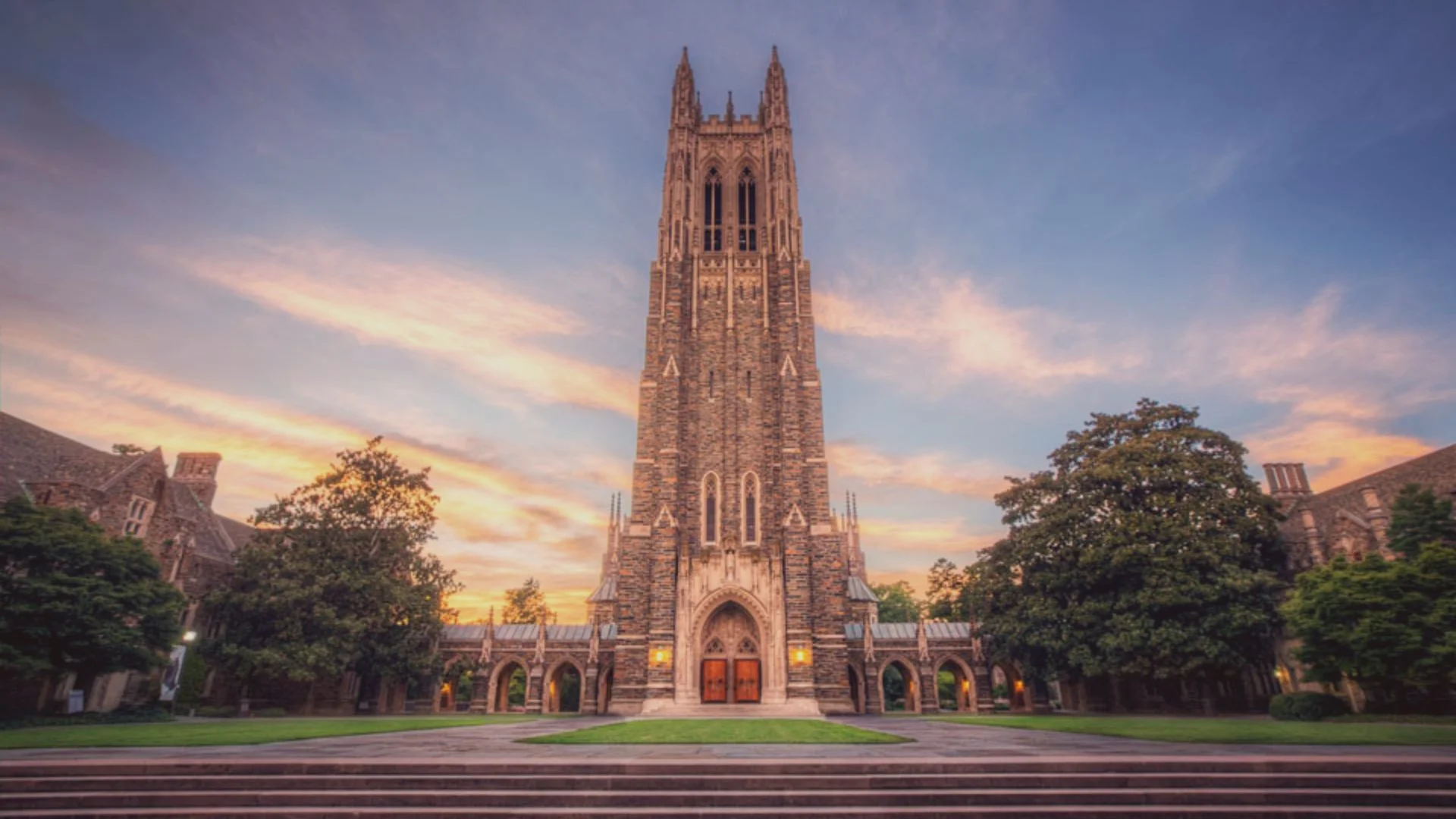
Nestled in Durham, North Carolina, Duke University is renowned for its stunning architecture, lush gardens, and vibrant academic community. Founded in 1838, Duke has grown to become one of the most prestigious universities in the United States. Its sprawling 8,600-acre campus features a harmonious blend of Gothic-style buildings and modern facilities, providing a picturesque setting for learning and exploration. Whether you are a prospective student, a curious visitor, or an alumnus, a campus tour of Duke University offers an immersive experience into the heart of one of America’s leading educational institutions.
The Historical Significance of Duke University
The Origins
Duke University began as Brown’s Schoolhouse, a humble preparatory school in Randolph County, North Carolina. It was later renamed Union Institute Academy, then Normal College, and eventually Trinity College in 1859. In 1924, James Buchanan Duke established The Duke Endowment, transforming the college into Duke University in honor of his father, Washington Duke. This endowment facilitated the expansion of the university, including the construction of the West Campus and the iconic Duke Chapel.
Architectural Marvels
The architecture of Duke University is a testament to its rich history and evolution. The campus is divided into three main areas: East, West, and Central. The East Campus, home to the university’s first buildings, features Georgian-style architecture and serves as the residential area for first-year students. The West Campus, known for its Gothic architecture, is the university’s academic and administrative hub. The Central Campus, a blend of residential and academic facilities, acts as a bridge between the East and West Campuses.
Exploring the East Campus
East Campus Highlights
The East Campus, with its expansive lawns and Georgian-style buildings, provides a welcoming atmosphere for first-year students. Key highlights of the East Campus include the East Duke Building, the Crowell Building, and the iconic East Campus Quad. The East Duke Building houses the Department of Theater Studies and the Dance Program, offering students state-of-the-art facilities for their artistic pursuits. The Crowell Building, home to the History Department, is another architectural gem worth exploring.
Residential Life
The East Campus is primarily residential, with dormitories that foster a strong sense of community among first-year students. The dorms, such as Aycock, Bassett, and Bell Tower, are designed to promote interaction and collaboration among students. The Marketplace, the main dining facility on East Campus, offers a variety of dining options, ensuring that students have access to nutritious and delicious meals.
Discovering the West Campus
The Heart of Academic Life
The West Campus is the epicenter of academic and administrative activities at Duke University. The iconic Duke Chapel, with its soaring spire and intricate stained glass windows, is the centerpiece of the West Campus. Built in the Gothic architectural style, the chapel is a symbol of the university’s heritage and commitment to excellence. It serves as a place of worship, reflection, and community gatherings.
Academic Buildings
The West Campus is home to several key academic buildings, including the Perkins Library, the Fitzpatrick Center for Interdisciplinary Engineering, Medicine, and Applied Sciences, and the Levine Science Research Center. The Perkins Library, with its extensive collection of books and research materials, is a vital resource for students and faculty. The Fitzpatrick Center, known as the CIEMAS, houses state-of-the-art laboratories and classrooms for engineering and applied sciences. The Levine Science Research Center, one of the largest interdisciplinary research facilities in the country, fosters collaboration among scientists and researchers from various fields.
Residential and Social Life
The West Campus also offers a vibrant residential and social life. The residential quads, such as Kilgo, Few, and Craven, provide comfortable living spaces for upperclassmen. The Bryan Center, a hub of student activity, houses dining facilities, theaters, and the university store. It is the perfect place for students to unwind, socialize, and engage in extracurricular activities.
The Central Campus Experience
Bridging East and West
The Central Campus serves as a bridge between the East and West Campuses, offering a mix of residential, academic, and recreational facilities. It is home to the Nasher Museum of Art, the Rubenstein Arts Center, and several residential complexes. The Nasher Museum of Art, with its impressive collection of contemporary and classical art, provides a cultural enrichment experience for students and visitors alike. The Rubenstein Arts Center, known as “The Ruby,” is a hub for artistic innovation, featuring studios, theaters, and performance spaces.
Residential Facilities
The Central Campus offers a variety of housing options, including apartment-style living for upperclassmen and graduate students. The residential complexes, such as 300 Swift and the Townhouses, provide a comfortable and convenient living environment. These facilities are equipped with modern amenities, including fitness centers, study lounges, and communal spaces, promoting a balanced and fulfilling campus life.
Recreational Spaces
The Central Campus also boasts several recreational spaces, including the Duke Gardens, the Wilson Recreation Center, and the Brodie Recreation Center. The Duke Gardens, a 55-acre haven of beauty and tranquility, features meticulously landscaped gardens, walking trails, and serene ponds. It is a popular spot for relaxation, study, and outdoor activities. The Wilson and Brodie Recreation Centers offer state-of-the-art fitness facilities, swimming pools, and sports courts, ensuring that students have ample opportunities to stay active and healthy.
Notable Landmarks and Attractions
Duke Chapel
No visit to Duke University is complete without a visit to the Duke Chapel. This architectural masterpiece, completed in 1932, stands at the heart of the West Campus. The chapel’s 210-foot tower, adorned with intricate stone carvings and statues, is a sight to behold. Inside, the chapel features a magnificent pipe organ, stunning stained glass windows, and a serene atmosphere conducive to contemplation and worship. The chapel hosts various events, including religious services, concerts, and weddings, making it a central part of campus life.
Sarah P. Duke Gardens
The Sarah P. Duke Gardens, located on the West Campus, is one of the most beautiful and tranquil spots on campus. Spanning 55 acres, the gardens are divided into four main areas: the Historic Gardens, the Doris Duke Center Gardens, the Culberson Asiatic Arboretum, and the Blomquist Garden of Native Plants. Each area offers a unique experience, showcasing a diverse range of plant species and landscape designs. The gardens are a popular destination for students, faculty, and visitors, providing a peaceful retreat from the hustle and bustle of campus life.
Nasher Museum of Art
The Nasher Museum of Art, located on the Central Campus, is a cultural gem that showcases a diverse collection of contemporary and classical art. The museum’s permanent collection includes works by renowned artists such as Pablo Picasso, Andy Warhol, and Kara Walker. In addition to its permanent collection, the Nasher Museum hosts rotating exhibitions, lectures, and educational programs, making it a vibrant hub for the arts. The museum’s modern architecture and serene outdoor spaces create a welcoming environment for visitors to explore and appreciate the arts.
 Student Life and Activities
Student Life and Activities
Clubs and Organizations
Duke University offers a rich and diverse array of student clubs and organizations, catering to a wide range of interests and passions. From academic and professional societies to cultural and recreational clubs, there is something for everyone. Notable organizations include the Duke Student Government, the Chronicle (the student newspaper), and the Duke University Union, which organizes events and activities throughout the year. These clubs and organizations provide students with opportunities to develop leadership skills, pursue their interests, and make lifelong connections.
Athletics and Sports
Duke University is renowned for its athletic programs, particularly its men’s basketball team, the Duke Blue Devils. The Blue Devils have a storied history, with numerous NCAA championships and a passionate fan base. The Cameron Indoor Stadium, home to the Blue Devils basketball team, is one of the most iconic sports venues in college basketball. In addition to basketball, Duke offers a wide range of varsity sports, including football, soccer, lacrosse, and track and field. The university also has extensive intramural and club sports programs, ensuring that all students have opportunities to participate in athletic activities.
Performing Arts
The performing arts are an integral part of student life at Duke University. The university boasts several performance venues, including the Reynolds Industries Theater, the Sheafer Lab Theater, and the Baldwin Auditorium. These venues host a variety of performances, from theater productions and dance recitals to concerts and lectures. The Duke University Department of Theater Studies and the Dance Program offer students opportunities to develop their talents and showcase their work. The university also hosts visiting artists and performers, providing the campus community with access to world-class cultural experiences.
Academic Excellence
Renowned Faculty
Duke University is home to a distinguished faculty, including Nobel laureates, Pulitzer Prize winners, and members of prestigious academies. The faculty is dedicated to providing a rigorous and engaging educational experience, fostering intellectual curiosity and critical thinking. Notable faculty members include Dr. Paul Modrich, a Nobel Prize-winning biochemist, and Dr. Robert Lefkowitz, a Nobel Prize-winning chemist. The university’s commitment to academic excellence is reflected in its low student-to-faculty ratio, ensuring that students receive personalized attention and mentorship.
Innovative Programs
Duke University offers a wide range of innovative academic programs, designed to prepare students for the challenges of the 21st century. The university’s interdisciplinary approach encourages students to explore multiple fields of study and develop a well-rounded education. Notable programs include the Pratt School of Engineering, the Sanford School of Public Policy, and the Duke Global Health Institute. These programs provide students with opportunities for hands-on learning, research, and collaboration with leading experts in their fields.
Research Opportunities
Research is a cornerstone of academic life at Duke University. The university is a leading research institution, with extensive resources and facilities dedicated to advancing knowledge and innovation. Students have access to





